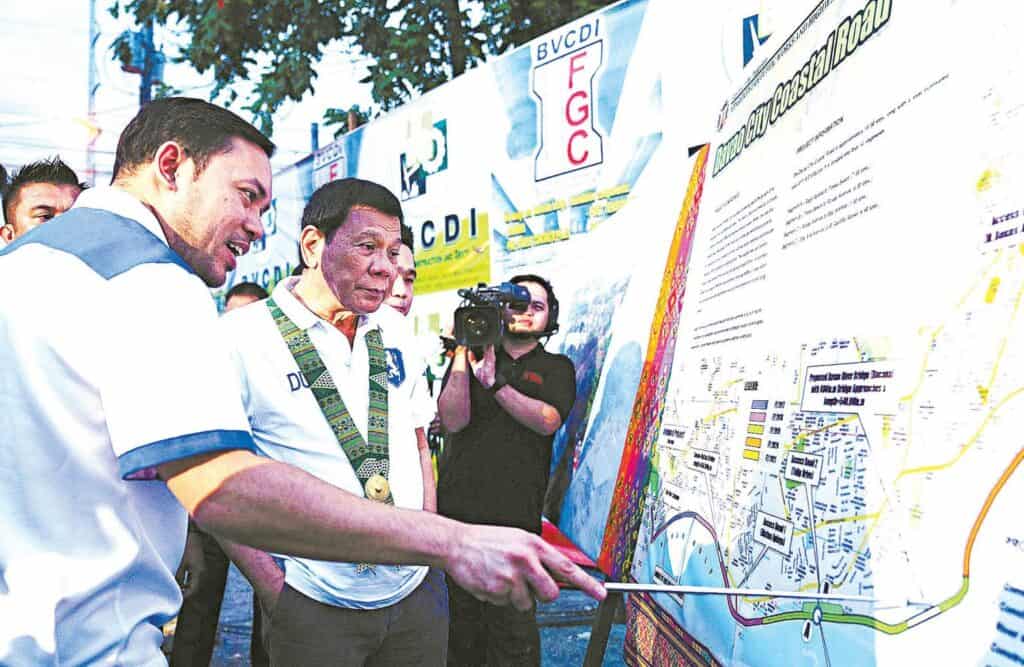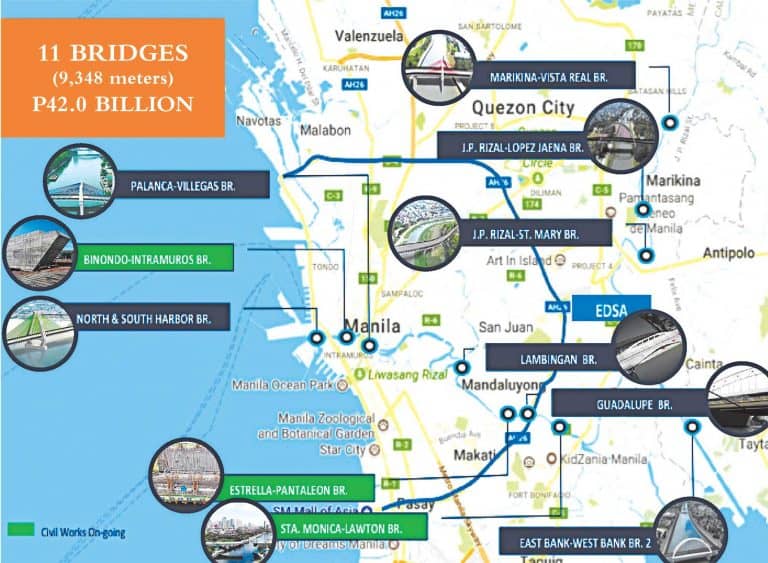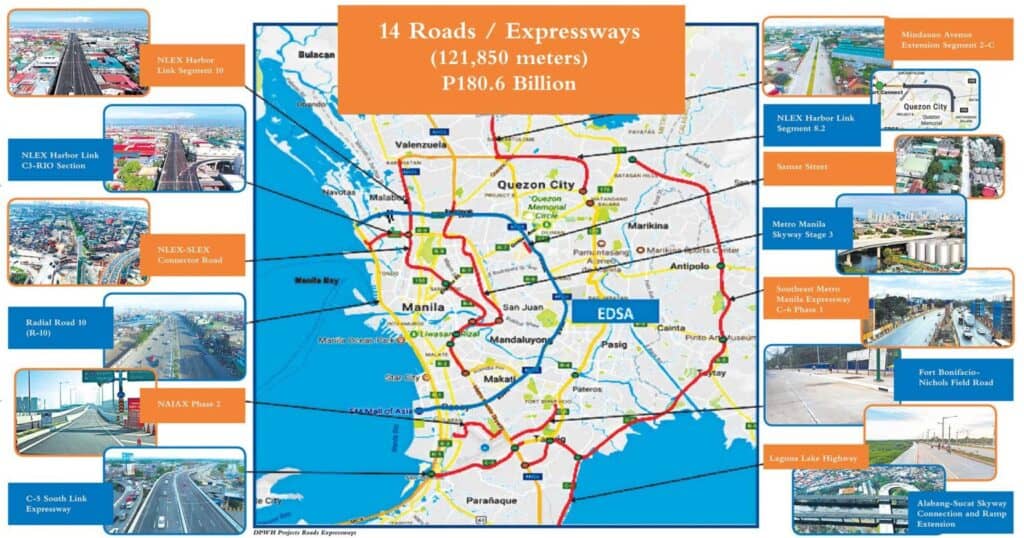
LONG AND grueling hours on the road mostly because of the horrendous traffic at EDSA will soon be over for motorists as the Department of Public Works and Highways (DPWH) advances its move to solving the Metro’s traffic woes.
The DPWH, led by Secretary Mark Villar, is poised to significantly complete its grand EDSA Decongestion Masterplan by 2022. Composed of a network of infrastructure projects, the masterplan aims to make it possible for motorists to reach every city in Metro Manila as well as go from North Luzon Expressway (NLEX) to South Luzon Expressway (SLEX) and vice versa in as short as 20 minutes to as long as 30 minutes.
For Secretary Villar, the achievements of the program will finally realize the promise of President Rodrigo Duterte to decongest EDSA. “When the EDSA Decongestion Program is completed, we will be able to free up major thoroughfares by at least 120,000 vehicles. By 2022, every city in Metro Manila will be reachable within a 20- to 30-minute time frame,” he added.
The program involves 14 roads and expressways spanning 121,850 meters and amounting to P180.6 billion, coupled with 11 bridges spanning 9,348 meters and worth P42 billion.

Among the projects at the forefront of the masterplan is the soon to open Metro Manila Skyway Stage 3 project, an 18.83-kilometer elevated expressway starting from Buendia, Makati City to NLEX in Balintawak, Quezon City. Completed earlier in October, this P44.86 billion project of conglomerate San Miguel Corp. will cut travel time from Buendia to Balintawak from two hours to 15-20 minutes. It will decongest EDSA and other major roads in Metro Manila by as much as 55,000 vehicles per day.

Complementing this project is the NLEX-SLEX Connector Road of the Metro Pacific Tollways Corp. (MPTC). The eight-kilometer, four-lane elevated expressway extends the NLEX southward from the end of Segment 10 in C3 Road, Caloocan City to PUP Sta. Mesa in Manila. The connector road also links to the Skyway Stage 3. According to DPWH, the project is currently 11% complete and is set to be finished by March 2022. Once completed, the project will reduce travel time from SLEX to NLEX from two hours to 20 minutes, benefitting 35,000 motorists daily.
Also set for completion by 2022 is MPTC’s C5 South Link Expressway. The project, worth P12.65 billion, is a 7.70-km, six-lane expressway from R-1 expressway to SLEX/C5. It will slash travel time from 40 minutes to 10 minutes. The Merville to C5/SLEX portion of the project, also known as Segment 3A-1, was opened to traffic in July last year; while Segments 2 and 3A2 broke ground last July.
The Southeast Metro Manila Expressway, a 32.66-km toll road from Skyway/FTI in Taguig City to Batasan Complex in Quezon City, will also be able to serve motorists by 2022. The P45.29 billion project will cut travel time from Bicutan to Batasan from one hour and 50 minutes to 26 minutes, benefitting as much as 88,338 motorists per day. The first section of the project, traversing from Skyway/FTI to C5/Diego Silang, is currently 12% complete, according to the department.
As motorists look forward to those projects for about two years, they can look forward to the completion of four projects by next year, including the Fort Bonifacio-Nichols Field Road, Mindanao Avenue Extension (Segment 2C), Laguna Lake Highway, and the Southbound portion of the Alabang-Sucat Skyway Connection and Ramp Extension.
The Fort Bonifacio-Nichols Field Road project, in particular, widens the 3.3-km Nichols Field Road from four lanes to six lanes.
Through this project, the DPWH explained, adjacent thoroughfares like EDSA, South Superhighway, and C5 will be decongested and travel time going in and out of Bonifacio Global City will be lessened. The project is 60% complete at present.
The Mindanao Avenue Extension (Segment 2C), meanwhile, is a 3.2-km, four-lane divided highway at the intersection of NLEX to Gen. Luis Avenue that will connect the areas of Valenzuela, North Caloocan, Quezon City (Novaliches), and NLEX. Once finished, the extension will cut travel time between Quirino Highway and General Luis Road from one hour and 30 minutes to 20 minutes. It is already 74.35% complete, according to the department.
The Laguna Lake Highway, on the other hand, is already substantially completed. The 6.94-km, four-lane divided highway will bring down travel time from Taytay, Rizal to Bicutan, Taguig from one hour to only 30 minutes.
All these upcoming road and expressways will form a basket of solutions to decongest EDSA, alongside already completed projects under the current administration such as the NLEX Harbor Link Segment 10, NLEX Harbor Link C3-R10 Section, NAIA Expressway Phase 2, and the widening of Radial Road 10 and Samar Street.
BRIDGES AND BIKE LANES
Aside from the new and expanded roads and expressways, new bridges will largely contribute in easing traffic along EDSA and other major roads in Metro Manila. DPWH said a four-lane bridge across Pasig River connecting Lawton Ave. in Makati City and Sta. Monica Street in Pasig City is poised to open next year. The Binondo-Intramuros bridge and the Estrella-Pantaleon bridge are also targeted for completion next year. Also, construction of three bridges crossing the Pasig River and Manggahan floodway under a Chinese financing facility is in the pipeline, while three more bridges crossing Marikina River will be built via funding through Asian Developments Bank’s financing facility.
The DPWH will also be embarking on a P7.93 billion Metro Manila Priority Bridges Seismic Improvement Project, which will entail the replacement of outer bridges and substructure of the Guadalupe bridge and the vertical geometry improvement of the Lambingan bridge.
Along with building roads and bridges to decongest traffic, the DPWH also supports the promotion of active modes of transport as bike lanes will be incorporated in the future projects of the department.
Particularly, Sec. Villar has issued a policy prescribing the standard design of bicycle lanes along national highways. Through Department Order No. 88 series of 2020, the secretary continued, the construction of new national roads and bridges or future expansion of projects (e.g., road/bridge widening, diversion/bypass roads, among others) shall incorporate a bicycle facility contingent on the prevailing road and traffic conditions but will have no less than 2.44 meters of bicycle path width.
In addition, the desirable width of three meters is set for a two-directional separated bike lane, unless under constrained condition, upon which the absolute minimum of 2.44 meters will be followed.
“With bike-friendly infrastructure, we aim to promote road safety to all and encourage the public to consider biking as a safe mode of transportation beneficial to their physical health, the environment through reduced greenhouse gas emissions and noise pollution, to traffic, and to public roads that render less wear and tear,” Sec. Villar said
#realestateblogph | #realestateblogphpropertynews | #REBPH
Article and Photo originally posted by Business World last October 28, 2020, 10:00am.







More Stories
Vista Land Celebrates 50 Years with Sandiwa: An Event Honoring Leadership, Legacy, and the Filipino Dream of Homeownership
Vista Land Celebrates Love Month in Ilocos Region
Vista Land Bridges Cebuano Heritage and Progress with Valencia by Vista Estates